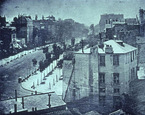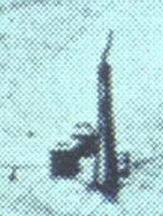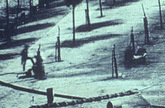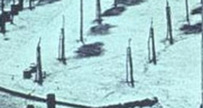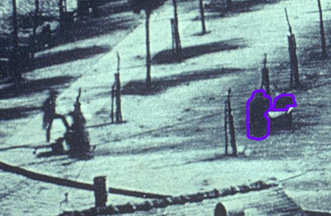day by day: a blog
August 22, 2007
traces
It is gratifying that Chris Rovee has expertly followed up with me again, this time commenting on a post he originally inspired, "Morse's Vision", in which I discussed Samuel F. B. Morse's description of his meetings with L. J. M. Daguerre in Paris in 1839.
Morse was particularly taken with what is now one of the best-known of the Frenchman's own daguerreotypes, the image usually called Boulevard du Temple. The striking impact of the photograph on Morse had much to do with the way in which Daguerre's method required a long exposure time to achieve a fully-detailed print on the silver-coated mirror surface of the photographic plate. (There is an interesting account by Geoffrey Hopkins of the actual techniques involved in the "Daguerreian Process", published in the Scientific American of 22 January 1887.) As a result, Daguerre, Morse wrote, created an image in which the "Boulevard, so constantly filled with a moving throng of pedestrians and carriages, was perfectly solitary, except an individual who was having his boots brushed." Morse explained that the individual's "feet were compelled, of course, to be stationary for some time, one being on the box of the boot-black, and the other on the ground."
To put it at its gentlest, I am no expert on the historiography of early photography. However, based on a cursory examination of some of the available literature, it seems to me that most art-historians second Morse in finding only a single figure captured, even if imperfectly, on the plate of Boulevard du Temple — the "individual who was having his boots brushed." As if to butrress that assertion, the passive voice in which Morse cast this sentence contrives to suggest that this cleaning process was happening without the intervention or actions of another person. The "individual" stood still and his boots were magically polished and brushed by invisible, or by linguistically occluded, hands. Thus it was that, as a free gift which came accidentally with the boot-blacking, this nameless "individual" became what writers on the subject have routinely called "the first person" ever to be photographed. (Mary Warner Marien's reading of the image in her excellent Photography: A Cultural History and Geoffrey Batchen's in Burning with Desire: The Conception of Photography are important exceptions to this myopic account of Daguerre's photograph.)
While writing "Morse's Vision" I had wondered myself about the accuracy of this notion that only one person is represented, but in my post I deferred lazily to the consensus opinion. However, Chris Rovee asks me: "do you really think the boot-black isn't visible?" Chris, along with Warner Marien and Batchen, is right. He has prompted me to re-examine and to contemplate this photograph with the kind of scruple that, amazingly enough, I had not exercised before. After doing that, it is clear that Boulevard du Temple possesses a number of complexities or ambiguities which have received little accounting from me, and perhaps from others, so far. Because this is the case, at least for a while it feels to me like the right time to get positivistic (dreaded word!) about Daguerre's image.
Among the principle group of issues which need an answer are important questions about the number of human presences (or absences) in the photograph, the time of day when the photograph was taken, the place which it was taken from, the nature of the social space on the main street captured in the image, the boulevard du Temple (part of the boundary between the 3rd and 11th arondissements), and the interpretive context in which Daguerre intended this photograph to be seen. In actuality, all these questions are interrelated but, for the sake of clarity, I am going to split them up. So, why not begin with a simple and yet apparently irresoluble problem? — the number of humans actually shown in the photograph.
Walter Benjamin insisted that, paradoxically, the "cult value" of the aura staged a last, elegiac moment of resistance to capitalist "exhibition value" in the first photographs, the products of the medium which was destined to destroy it. The "portrait is central to early photography. In the cult of remembrance of dead or absent loved ones, the cult value of the image finds its last refuge. In the fleeting expression of a human face, the aura beckons from early photographs for the last time." By 1847, less than a decade after Daguerre's invention was first unveiled to the public, photography had become a popular middle-class craze all over Europe and the United States with portraits studios in such places as Paris taking upwards of 3,000 portraits a year.
But this vogue had been enabled by a rapid series of technical developments in the years after 1839. These included much faster exposure times, the reduction in size of photographic equipment, and improvements in accelerated chemical processing of the captured image. Photographers had been trying to take portrait images around September 1839. The first, and only very partially successful, image in which a person is the specific target of the camera's gaze was shown by Alfred Donné in October 1939. But, then, and for some time afterwards, the process involved an extreme physical trial on the subject's part. Helmut and Alison Gernsheim, amongst the great historians of early photography, comment: "During 1840 it was still necessary to pose for several minutes in sunshine — a very long time to keep motionless — and the ferocious expression of the few intrepid people who submitted to themselves to such experiments bore witness to their resolution and ordeal." In fact, contra Benjamin, the earliest photography, such as the images made by Daguerre himself, had enormous difficulty in recording human presence at all, still less the details of a specific human face.
The Daguerrian image which I discussed in "Morse's Vision" and which I show again here, was evidently taken either in the early morning or the late afternoon when sunlight was flooding at a gentle angle laterally into the city from either the east or the west, and when the shadows cast by the trees and houses on the boulevard du Temple are correspondingly quite long.
According to the Gernsheims in L. J. M. Daguerre: The History of the Diorama and the Daguerreotype, Daguerre took the images from his laboratory-eyrie in the 350-seat Diorama Building, which stood at 4, rue Sanson, at the intersection with the rue des Marais, and which from the back looked out roughly southwards, high over the rooftops, towards boulevard du Temple.
The maps above mark the former and actual location of the Diorama in blue and the location of boulevard du Temple in red. The map on the left above, showing the "Emplacement du diorama", is taken from Georges Potonniée, Daguerre: Peintre et décorateur (Paris, 1935). It is reproduced in R. Derek Wood, "Daguerre and His Diorama in the 1830s: Some Financial Announcements" (1997- ). The buildings in this area of Paris was almost completely razed, while old streets were destroyed and new ones built during the Haussmannizing of the district and the creation of place de la République between 1854-79. Wood notes that the site of the Diorama in present-day Paris is roughly at "the south side of rue Léon Jouhaux just off the north corner of place de la République". This is shown in the map on the right above, courtesy of Google Earth.
The Gernsheims say that from that vantagepoint Daguerre captured a number of images of the boulevard du Temple, at least one showing it in the morning, one at noon, and one in the evening. Others images of the boulevard du Temple included some showing blurred images of horses in the street. Morse saw some, or perhaps all, of these now lost pictures.
I will come back on another occasion to the exact time of day shown in the photograph we are considering. But for today's task, the purpose of determining how many people are shown in the best-known Boulevard du Temple image, it is sufficient for now to note that the picture of the man having his shoes blacked was taken when the shadows were long, and hence either relatively early or late in the day.
Another, brighter image of the same spot (reproduced here), shows the shadows cast by the boulevard's trees as considerably reduced in size. This image must therefore have been made around noon when the sun was more or less directly overhead. It shows no-one at all, or almost no-one at all, on the street. In reality of course many people must have been passing back and forth for the several minutes when light made its way into Daguerre's camera, but very few stayed still long enough for their presence to be captured legibly on the photographic plate.
This second, noon-time picture does clarify some of the visual enigmas of the first. What is there in the first image is not present in the same place in the second. It shows, for example, that the boot-black had two boxes close to one another on the pavement (see enlargement on right). Customers could rest their feet on these cube-like boxes while he performed his services for them (see enlargement on left). It is quite possible that the second box may have belonged to a companion worker. Why would one shoe-black need two boxes? Here is John Sanderson's exactly contemporaneous, and superlatively condescending, description of a Parisian shoe-black (in French, a "cireur de bottes") in his The American in Paris, published in 1838:
Let me introduce you to this shoe-black. He has, as you see, a little box, a brush or two in it, and blacking, and a fixture on the top for a foot; this is his fond de boutique, his stock in trade. He brushes off the mud to the soles of your feet, and shews you your own features in your boots for three sous.
The second image which Daguerre made of the corner of boulevard du Temple at its intersection with a side street, rue des Fosses du Temple (as I will explain later), thus elicidates exactly what we are looking at in the first picture: the composite shape registered by the camera is made up from a customer, a boot-blacker, two wooden boxes and a tree sapling. In the enlargement below, I have outlined the shape of the boot-black's crouched figure in purple.
All of this makes coherent, logical sense. A man stops for a shoe-shine in the early morning before heading to his daily round or later in the afternoon after the city has left its patina of mud and dust on his feet. At midday, when the sun is overhead, the temperature is at its hottest, the day is already half-done, and the wealthier people, the cireur de bottes's clientele, in the area are inside being served lunch. As such, business is slack for the boot-black, who has retired into the shadows, probably to eat, stay cool and to wait for a customer. Daguerre's incomparably beautiful, waxing and waning shadows are like a social and economic sundial telling the time of the street's financial day.
(Incidentally, the fullness of the foliage on most of the trees, the starkness of the shadows on the pavement, the shops' extended awnings, and the apparent brightness of the day all seem to suggest that these images cannot have been taken in the late winter or early spring of 1839. Daguerre showed at least some of the Boulevard du Temple pictures to Morse on 8 March 1839 when for some months Paris cannot have looked quite so summery. This indicates that the photographs were probably made in the summer of 1838, not, as is usually assumed, 1839.)
As far as Chris's and my discussion of the best-known image of the boulevard du Temple taken by Daguerre is concerned, my conclusion is that the image does not show an isolated bourgeois subject, who has remained visible and legible while all the traces of labour on which he relies for his social standing, in this instance the presence of a labourer who stoops to shine the bourgeois' shoes, have failed to register and hence have become "invisible" to history.
Instead, if one actually pushes past one indifference and pursues the image's ghosts, one sees the image of one semi-destitute man or child hunched immobile over the raised foot and straight torso of another, wealthier, more "upright" person. The cognitive erasure of the street labourer's bent back in subsequent critical discussions of this photograph is a result not simply of photography's technical limitations at the period but of the class-based perspectives held by many among the early makers of, and the audience for, photography.
In the context in which my conversation with Chris about this picture has arisen, the subject of a microscopic attentiveness is therefore not to be circumscribed solely as one of the essential markers of modern poetics. It is also the prerequisite for restoring to art and history alike a sense of social reality. It would take until Atget's turn-of-the-century images of Parisian rag-pickers and the publication of the first installment of Georg Sander's Antlitz der Zeit series in 1929 that the worker's back could truly unbend before the photographer's lens. Then, at least, the disadvantaged figure in the photograph could be allowed a face, if not yet given a name.
But if, looking again, at the boulevard du Templeimage, we can be almost certain that there are at least two people registered on Daguerre's silver-coated plate, we might also be tempted to go even further. At the risk of beginning to sound like a parody re-enactment of Antonioni's Blow-up, enlargements of the photograph, even of the relatively crude kind which I am able to make on the trusty Rosinante of my ancient laptop, suggest there may be one more person, or perhaps even two more people, hidden in the image.
If one looks to the right of the pedestrian and boot-black cluster, on the same stretch of pavement one can discern a curious, large lumpy shape, also stationed by a sapling (see enlargement on left). It looks as if it is constituted from several dark objects as well as from something bright white. A cloth? A sheet of paper? A map? A poster? This second, composite shape is of very similar dimensions to the pedestrian and boot-black grouping. Likewise, the "shape"'s outline is composed of straight lines and curves as is the case with the more obvious grouping. And, again, as is true of the boot-black and customer, in the daguerreotype made at around mid-day, this second "shape" is not present (see enlargement on right).
No definitive assertions seem possible, especially since the complete images themselves are so relatively tiny. The Boulevard du Temple image was captured as a "whole-plate" size. That means that the entire image was roughly 6.5 inches high and 8.5 inches wide. The details within the image which we are talking about here thus occupied tiny fractions of an inch of the original, and only, plate. (Again, more about the plate's physical history on another occasion.) But, allowing for the visual ambiguities attendant on examining an image of such a small scale, it is hard to know what else the "lumpy shape" on the street to the right of the customer and boot-black might be except at least one other figure (see enlargement outlined in purple above). The "thing" must be able to move because it is not present in the other, noon-time photograph. It was thus present when other humans were standing or crouching still enough to be impressed on Daguerre's camera plate, and yet mobile enough to be absent when the other figures were absent too. In particular, the human-sized shape to the left side of the white sheet, the shape which has inward-bending curves where one would expect shoulders on a human, and a ball-like protuberance where one would expect a head, seems hard to decipher as anything but a seated person. As for the other, right-hand side of the shape — perhaps another human presence bending forwards to examine something or to read it?
My claim is that Daguerre's Boulevard du Temple image, one of the best-known and most admired pictures in the history of early photography shows not one person, as many have assumed, and not two, as a few discerning critics have noticed, but three people and perhaps even four — a populated micro-world into which we can, and should peer, even though it is only like looking through a glass darkly.
What difference does that make to our interpretation of the photograph? To use an old-fashioned expression, "Stay tuned", or a new-fangled, and much less truthful, one — "We'll be right back."
Posted by njenkins at August 22, 2007 06:48 PM
With the exception of interspersed quotations, all writing is © 2007-09 by Nicholas Jenkins


